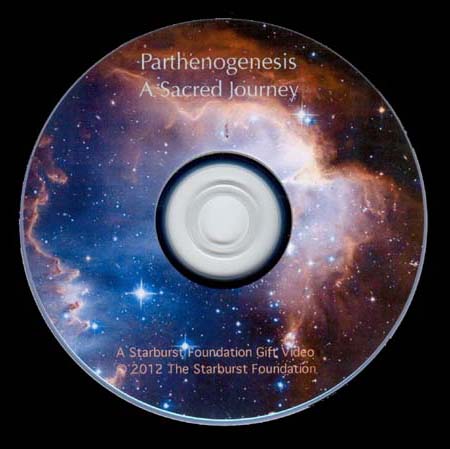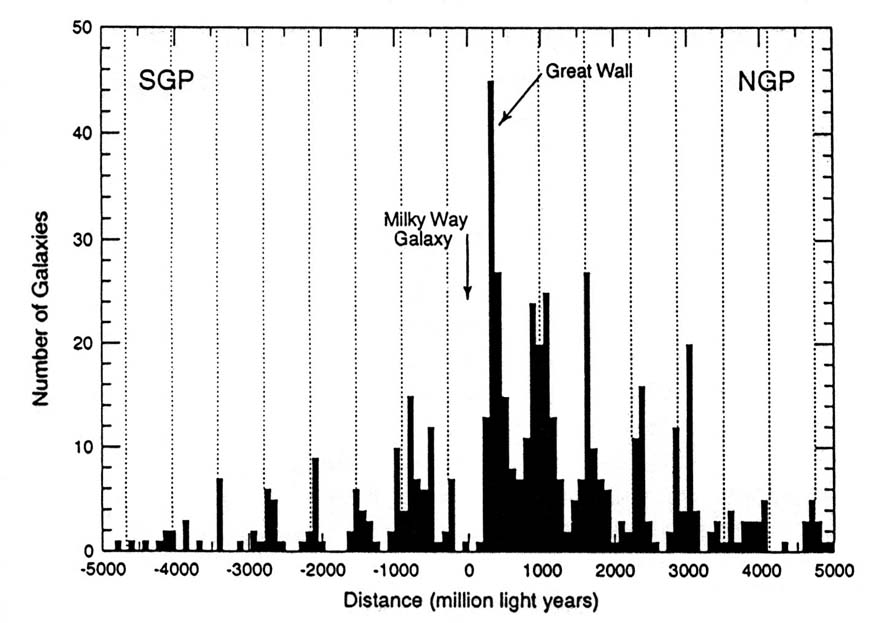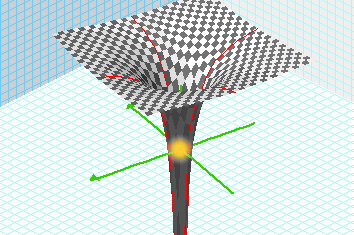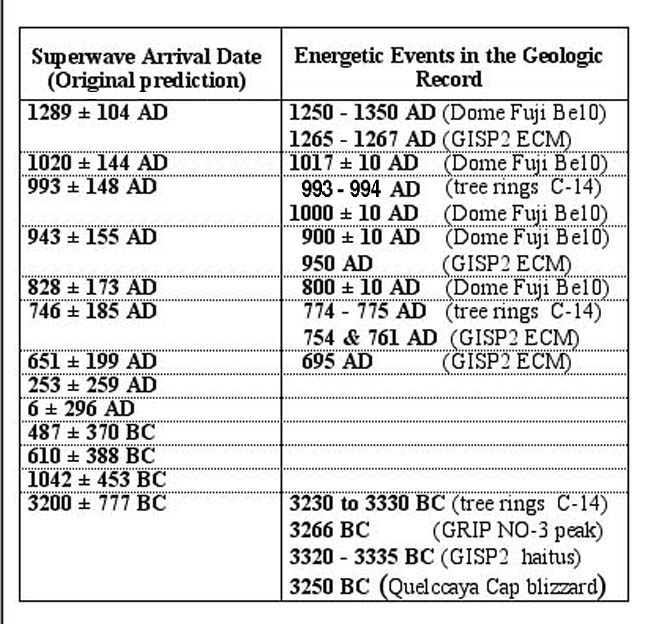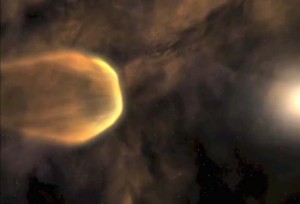Author Archives: Paul
Researchers identify largest ever solar storm in ancient 14,300-year-old tree rings
Astrophysicist Paul Alex LaViolette, PhD has passed away
Paul Alex LaViolette, a Doctorate of Philosophy in Systems Science, was an astrophysicist, an inventor and a philosopher whose thinking was outside the box: a Renaissance Man. Dr. LaViolette was president of the Starburst Foundation under whose aegis he had been conducting interdisciplinary research in physics, astronomy, ecology, climatology, systems theory, psychology and ancient mythology. He is the originator of theories in areas of astronomy, physics, geology, and cognitive psychology which have been published in various professional journals and provide explanations to various thus far inadequately answered questions. His published books and articles explain the theories he has put forth and in them he substantiates each tenant in detail based on extensive, in-depth painstaking research. His book titles include: Genesis of the Cosmos: the Ancient Science of Continuous Creation (first print published as Beyond the Big Bang), Subquantum Kinetics, Earth Under Fire, Decoding the Message of the Pulsar, and Secrets of Antigravity Propulsion which was an Amazon top seller the first year and presents a comprehensive study of advanced propulsion systems propelling unconventional flying objects and classified craft such as the B-2 bomber and other advanced craft such as those seen around Area 51. He had also edited “A Systems View of Man,” essays by systems theorist Ludwig von Bertalanffy. Some of Paul’s books have been published in several languages including but not limited to Greek and Russian. His publications are detailed on his website etheric.com.
Paul served as a solar energy consultant for the UN, the Club of Rome, and the Greek government and had also consulted with Hughes Aircraft Corp. on ways to improve innovation in the company’s work force. He has advised NASA on the advantages of field propulsion technology and participated in the critical review of the Columbia Space shuttle accident.
Paul and younger sister Mary were born in Niskayuna a suburb of Schenectady, New York, USA to a Greek-American Mom chemist and an American Dad physicist and engineer who had participated in the Manhattan Project. Paul’s insatiable curiosity was apparent from a very early age: his first word had not been Mama or Papa but “FOS” (“light” in Greek)! His father, who was a nuclear engineer at General Electric’s Knolls Atomic Power Laboratory, began teaching physics to Paul at elementary school age. As Paul grew he spent time with his chemistry set but was also a good piano student. As a young teen he enjoyed creating gunpowder rockets which he was allowed to launch in the backyard. Paul attended 9th and 10th grades at Niskayuna High School where by sophomore year he had become president of the science club and at age 16 invented a solar powered water pump which was promoted by VITA (Volunteers for International Technical Assistance) for use in developing countries and is being used in arid areas throughout the middle east up to today. In 1963 the family moved to Athens, Greece where his father was on assignment with the International Atomic Energy Commission to teach scientists at the Democritus National Research Center how to conduct experiments with their new “swimming pool” type nuclear reactor. The first year in Athens Paul attended Athens College where he took all the courses available in English – mostly math and science – but he did take trigonometry in Greek only to point out to the teacher an incorrect answer in the answer book! That year Paul took up playing the guitar. His father, who loved history, made a point of taking the family to visit the numerous archeological sites which all enjoyed. The next year Paul attended the American Community Schools in Halandri for his senior year and after graduating in 1965, Paul obtained a BS in Physics from Johns Hopkins University, an MBA in Organizational Administration from the University of Chicago, and a PhD in Systems Science from the State University of Oregon in Portland.
Paul’s college years were the years of the Vietnam war and, as a conscientious objector, Paul interrupted his MBA to complete two years of alternative service at Harvard University’s School of Public Health where he invented an improved pulsation dampener for air sampling pumps as well as a new type of life-support rebreather apparatus currently used throughout the world by firefighters and miners replacing dangerous oxygen tanks.
Paul’s curiosity in science and discussions with his father led him to spend hours and hours researching, reading and pondering. Thus his theories unfolded over many years. One evening at age 22 it all came together for him and his new theory of physics was born. Based on his theory, Paul made predictions about what would be encountered in outer space and posted these on his website. Then years later, when NASA was puzzled with some mission findings, Paul pointed out the correct explanation from the predictions he had posted.
Some of Paul’s firsts include:
Dr. LaViolette was the originator of subquantum kinetics, a novel unified field theory approach to microphysics which resolves many long-standing problems in physics and which provides a rational alternative to the big bang cosmology. Subquantum Kinetics has had 12 of its predictions later verified by astronomical observation. He is also the first to show that a similar science of matter-energy creation is metaphorically encoded in certain ancient creation myths and esoteric lore.
Paul was the first astronomer to disprove the expanding universe theory by showing its inability to fit observational data in a consistent manner. Paul has modified one of Newton’s laws and one of Einstein’s laws.
He was also the first to show evidence that energy is being spontaneously created inside planets and stars through a photon energy blue-shifting effect. His early predication of the magnitude of this frequency shift effect were confirmed in spacecraft tracking experiments which detected this blueshift, more commonly known as the Pioneer effect. He is also credited with discovering that the masses and luminosities of both planets and stars conform to the same mass-luminosity relation, a finding which led him to correctly predict that brown dwarf stars should also conform to this relation.
Dr. LaViolette was the originator of the galactic superwave theory which proposes that cosmic ray outbursts from the center of our Galaxy periodically trigger major shifts in the Earth’s climate. In testing this theory he became the first to discover high concentrations of cosmic dust and gold in ice age polar ice. He also initiated the world’s first discovery of anomalous isotopic ratios in extraterrestrial tin. In 1988 he initiated the current US-Russian ice core exchange program becoming the first U.S. glaciologist to receive polar ice samples from the former Soviet Union.
Paul correctly predicted that interstellar dust recently entered the solar system something that was confirmed ten years later by data received from the Ulysses spacecraft. Also, he uncovered evidence which establishes the past occurrence of immense solar flare storm outbursts causing a terrestrial conflagration. He was also the first to show evidence that the last ice age was ended by a global warming episode.
He was the first to reverse engineer the B-2 bomber’s propulsion technology and also was the first to explain the microwave beam technology used to propel vehicles developed in the super secret Skyvault Project.
Paul was the originator of the glacier wave flood theory that not only provides a reasonable scientific explanation for widespread continental floods at the end of the last ice age, but also presents a credible explanation for the sudden freezing of the arctic mammoths and demise of the Pleistocene mammals.
Dr. LaViolette’s findings about superwaves and their climatic effects have been spotlighted in documentaries which aired on the Discovery and History channels in the US.
Paul also had many accomplishments in Archaeoastronomy, Mythology and Esoteric Lore. His findings opened a new doorway to the interpretation of our ancient past. Aided by his background in general system theory and physics, he was able to successfully decipher the lost science said to be encoded in the lore of the Tarot and astrology. He found that the first 11 major arcana of the Tarot and the 12 signs of the zodiac both use symbolic metaphor to present an advanced science of matter and energy creation. He has shown that the systems-genesis concepts they encode were discovered by modern science only in the last 40 years. He was also the first to discover that this same advanced creation science is metaphorically encoded in certain ancient creation myths from various parts of the world:
* Egypt: the myth of Atum, the passion of Osiris;
* Greece: the Olympian creation myth, Plato’s story of Atlantis, the myth of Castor & Pollux;
* Near East: the Babylonian creation myth about Marduk and Tiamat, the Sumerian creation myth about An and Ki, the Phoenician myth about Adonis and Aphrodite;
* India: the Vishnu creation myth;
* New Zealand: the story of Rangi and Pappa;
* China: the I Ching.
Also he discovered the scientific significance of ancient Egyptian symbols such as the ankh, djed pillar, tyet, and aker sphinx; and of the Hindu symbol of Shiva Nataraja. He also found new evidence embedded in an ancient Egyptian text that supports the belief that ancient Magi performed initiation rites into the Osirian mysteries by entering an underground labyrinth symbolically accessed through the breast of the Sphinx. Furthermore, in the area of archeology and archaeoastronomy, Dr. LaViolette was the first to discover and decode a scientifically advanced time-capsule message concealed in the lore of the zodiac and which utilizes a cryptographic key-and-check mechanism to facilitate cross-cultural transmission of its encoded knowledge. He found that this cipher describes the Galactic and solar cause of the legendary global catastrophe that decimated civilization at the end of the last ice age and that gave rise to numerous myths about the darkening of the luminaries, burning of the Earth, and occurrence of a great flood. He discovered that the cipher related how an intense volley of cosmic rays, explosively emitted from the center of our Galaxy, had bombarded our solar system and pushed in light occluding particles of cosmic dust. This ancient scientific record inspired him to carry out an extensive program of interdisciplinary Ph.D. research to search for corroborating evidence. His findings were later published in refereed scientific journals. As such, Paul LaViolette may be the first to have conducted doctoral research for the purpose of checking out the validity of scientific information conveyed by a prehistoric time-capsule message.
He was the first to decipher the 14,000 B.C. date encoded in the Scorpius-Sagittarius zodiac constellations and in the Dendera ceiling zodiac. Also he was the first to work out the significance of the 10,750 B.C. date encoded in the Giza pyramid complex, the Beth-Alpha Synagogue mosaic, and in the ancient Greek myth of Astraea. His work provided new understandings of the ancient Minoan bull-leaping ritual, the Pleiadean rites, and the significance of myths connected with the Orion constellation. In addition, he provided new insights about the constellations of Scorpius, Sagittarius, Sagitta, Centaurus, and Taurus. He was also the first to decipher the astronomical significance of the South American Indian Barasana cosmology which refers to cataclysms caused by the Galactic center. Furthermore, he has elucidated the astronomical and geological significances of:
* the Hopi legend of the Blue Star,
* the ancient Egyptian myths about the punishing Eye of Atum-Re, the vengeful Eye of Horus, Horus’ nearly fatal scorpion sting, and the battle between Horus and Set,
* the ancient Greek myth of Phaethon and the Sun Chariot and Plato’s story of Atlantis,
* the Mayan Popul Vuh creation myth about the Heart of Heaven,
* the Nordic legend of Ragnarok about the death riders of Muspell and the Sun-swallowing Fenris Wolf,
* the Yurucare Indian conflagration legend, and many others.
Physics is only as good as the theories it is based on. Whatever is currently accepted theory is taught in schools and defended as religion. Twenty-five years ago US scientists who wanted to work on free energy were being black balled from receiving National Science Foundation grants. Paul had difficulty finding favor in mainstream academia in the US and was even persecuted but fortunately he developed many open-minded followers around the world. The scientific community as a whole has been slow in appreciating the importance of Paul’s contributions as his ideas depart, sometimes radically, from current norms in scientific thinking. The full impact of his theories were not embraced in his own lifetime. The German philosopher Arthur Schopenhauer said: “All truth passes through 3 stages. First, it is ridiculed. Second, it is violently opposed. Third, it is accepted as being self-evident.” Paul’s theories are expected to reach the third stage in the near future.
Paul lived in Athens, Greece and Niskayuna, NY with his wife Mariana Cristova and they enjoyed travelling wherever he was invited to lecture. He is survived by his wife Mariana, his sister Mary Margaret LaViolette, and his nephew, Anthony John Nicolopoulos. The funeral will be at 1:00pm Wednesday, 21 December 2022 at Zographou Cemetery in Athens. In lieu of flowers, donations to the Starburst Foundation, 1176 Hedgewood Lane, Niskayuna, NY 12309, USA, (or through the etheric.com website) are preferred.
The Generation of Mega Glacial Meltwater Floods and their Geologic Impact
Starburst Foundation press release: on glacierwaves

A new theory explains how mountain-sized waves of glacial meltwater could have been produced during the last ice age. In a paper published last month in the journal Hydrology: Current Research, Paul LaViolette describes how immense waves of glacial meltwater could have been produced on the surface of the North American and European ice sheets during periods of excessive climatic warmth when the ice sheet surface was melting at an accelerated rate.
He demonstrated that, during warm interstadial periods, the ice sheet surface would have been covered with perched lakes of glacial meltwater and that if a lake near the ice sheet summit were to catastrophically empty due to an ice dam breach the resulting discharge of meltwater would have sequentially triggered the emptying of other lakes as it descended the ice sheet surface. The resulting meltwater wave, called a glacier wave, would grow in size through a domino effect and by the time it reached the bottom of the ice sheet would achieved heights as great as 300 meters and be moving forward at a speed of 900 km/hr. Each meter of the wavefront would carry a kinetic energy of 12 million tons of TNT allowing it to surmount mountains possibly up to 1500 meters in height and to travel many hundreds of kilometers outward from the edge of the ice sheet. Such waves would have repeatedly discharged from the ice sheet surfaces during warm intervals.
Glacier waves would be able to account for the character of the permafrost deposits found in Alaska and Siberia, some of which are found at elevations as high as 650 meters above the valley floor. They could also explain how the remains of many extinct Pleistocene mammals had become shredded and enterred in these deposits. They could also explain the formation of the numerous drumlin field formations seen in North America, and of the many of the lignite deposits found in Europe, Siberia, and North America. The lignite deposit found in Megalopolis, a town in southern Greece, for example, is found at an elevation of about 400 meters above sea level and is ringed by mountains that rise as high as 1500 meters. The lignite appears to have been pulverized by violent forces before being catastrophically deposited in the Megalopolis basin.
Such waves could also account for how continental debris was transported thousands of kilometers into the mid North Atlantic to form the so called Heinrich layers. It is proposed that such layers form at times when a sea ice shelf covered the North Atlantic and bordered the ice sheet thereby allowing the glacier waves to travel great distances before depositing their debris in the ocean. Heinrich layers have been found as far as 3000 km from the edge of the ice sheet.
LaViolette notes that such waves would have posed a serious hazard to ice age man and animals and could be the source of the flood myths handed down by word of mouth in cultures all over the world. The paper entitled "The Generation of Mega Glacial Meltwater Floods and their Geologic Impact" may be downloaded at the following link: LaViolette, 2017.

Earth Engulfed by Superconducting Interstellar Dust Particles During the Last Ice Age
Press Release:
The Starburst Foundation, November 7, 2015
Paper finally published after 30+ year journal battle ordeal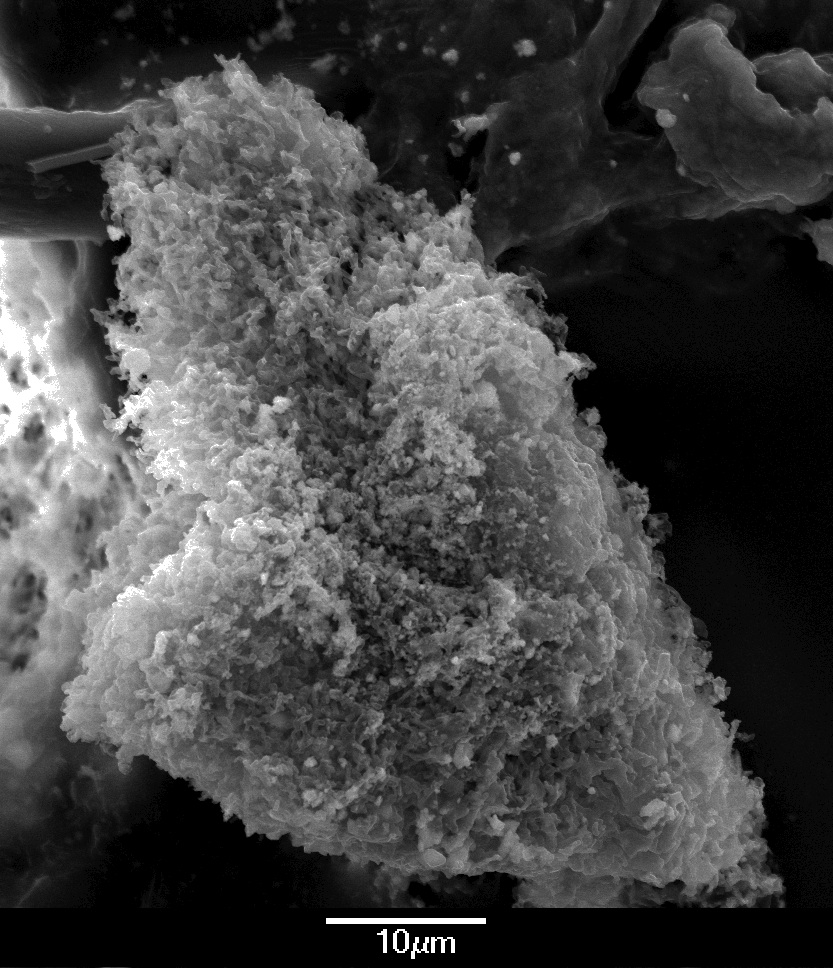
Samples retrieved from the ice age portion of the Camp Century, Greenland ice core show evidence that a major cosmic dust incursion episode occurred 49,000 years ago, the largest to occur in the past several hundred thousand years. Dr. Paul LaViolette, director of the Starburst Foundation, a New York based research institute, has found that over a period of at least 6 years, interstellar dust was entering the Earth's atmosphere at up to 100,000 times that of the current cosmic dust influx rate. He presents this discovery in a paper that that is appearing in the December 1st issue of Advances in Space Research (https://www.sciencedirect.com/science/article/pii/S0273117715006614).
(Full electronic version available free until December 27, 2015 at:
Advances in Space Research 56 (2015) 2402–2427
(Preprint pdf version: https://www.starburstfound.org/downloads/
superwave/tin-rich-dust.pdf)
What is unusual is that the composition of this dust does not match any hitherto known cosmic dust sources, for over half of the sample dust weight consists of tin and lead (49% tin and 8.4% lead). LaViolette finds that this heavy-metal-rich dust is most likely of interstellar origin since its lead-to-tin ratio matches that seen in spectroscopic studies of the nearby interstellar medium and makes a very poor match to the lead-tin ratio found in solar system dust and meteorites.
Equally interesting is the mechanism that LaViolette has proposed to explain the concentration and conveyance of this dust to the solar system. Even in interstellar space, tin and lead are believed to be present in relatively low cosmic abundances, on the order of a few parts per million. So LaViolette needed to explain how these elements came to be preferentially concentrated by a hundred thousand fold. One day the thought occurred to him that tin in its metallic state is superconducting at temperatures typically found in interstellar space and that superconductors are repelled by external magnetic fields through what is called the Meissner effect. A similar Meissner repulsion effect is used in levitating maglev trains. He theorized that propagating interstellar shocks having embedded magnetic fields would have tended to preferentially push these particles forward and in so doing cull them out from all the other dust that was not superconducting. This same mechanism could also explain the high concentrations of lead found in this sample since lead is another metal that is superconducting at interstellar temperatures. While the tin particles were found in their oxide form due to their long exposure to Earth's oxidizing environment, they would originally have been in their metallic state when present in the hydrogen-rich space environment.
LaViolette found that during the course of the 49 kyrs BP event the concentration of terrestrial wind blown dust present in Camp Century ice had decreased 33 fold, implying that the rate of ice accumulation had correspondingly increased 33 fold, perhaps reaching levels as high as 5 meters per year. This event occurred near the beginning of a climatic cooling episode known as Dansgaard-Oeschger stadial number 13 and was likely the cause of this global climatic cooling. This shows that cosmic dust influx into the solar system may play a key role in climatic change.
The high lead levels that were found in the tin-rich dust sample suggests that hazardous lead levels were present in snow and rain water that fell at that time. Lead was at over 10 times the maximum allowable threshold set by the U.S. EPA and could have posed a health hazard if such contaminated water had been consumed by wildlife or paleohumans.
LaViolette's scanning electron microscope results are also interesting. One tin oxide particle was found to have a length of 120 μm making it the largest monomineralic cosmic dust particle thus far reported. Also particles were imaged which had a porous aggregates morphology, some being embedded with numerous nanospheres similar to nanochondrules or GEMs found in cosmic dust particles.
The tin-rich sample was also found to contain very high levels of low melting point elements such as antimony, silver, and gold. In fact, this was the first time that anyone had detected gold in polar ice. LaViolette also found high levels of tin and lead (39% tin, 7.5% lead) in a 130,000 year old Camp Century polar ice dust sample. Again the lead-tin ratio conformed to that found in interstellar space. This indicates that Earth has had a history of recurrent incursions of tin-rich interstellar dust.
LaViolette began investigating these polar ice dust samples over 35 years ago as part of his Ph.D. research at the Portland State University Systems Science program. His dissertation was researching the hypothesis that intense Galactic cosmic ray particle volleys pass through the solar vicinity every 10 to 25 thousand years pushing nearby cosmic dust into the solar system. To test this "Galactic superwave" theory he analyzed a total of eight Camp Century ice core samples for the presence of 15 trace elements, among these iridium and nickel which were good indicators for the presence of cosmic dust. He chose samples from the ice age portion of the ice core with ages ranging from 40,200 to 78,200 years BP and analyzed them using a technique called neutron activation analysis. He found that five out of the eight samples had elevated levels of iridium and nickel, thereby confirming his hypothesis that the solar system is occasionally flooded with particles of cosmic dust. The sample having the highest levels of iridium was the anomalous tin-rich sample.
These results were surprising to most cosmochemists and astronomers since the idea of cosmic dust incursions recurring in geologically recent times was virtually unknown at that time. While he was able to publish his iridium and nickel findings in 1985, his findings on the tin-rich dust were met with skepticism due to the unusual composition of the sample. Repeated attempts to publish those findings were routinely blocked by journal referees who claimed that the high levels of tin were due to contamination that had somehow entered the samples.
Five of the eight samples that LaViolette analyzed had been previously filtered from ice samples processed by glaciologist Lonnie Thompson in a class 100 clean room and the tin-rich sample was one of these. So the sample contamination claim did not seem very convincing. Thompson had previously reported high levels of tin in both ice age tin-rich samples, but had attributed the presence of tin to bedrock scrapings that had somehow worked their way up through the ice. But, LaViolette's discovery of high levels of iridium, nickel, and gold in the 49 kyrs BP sample indicated an extraterrestrial origin for the tin as being far more likely.
The rejections of his paper did not deter LaViolette. Over the years he continued to resubmit his results to one journal after another, being rejected by a total of 10 different journals. Over time, the amount of evidence he had accumulated to support his cosmic origin hypothesis continued to grow. For example, in 1984 he sent a fragment of his tin dust sample to professor John deLaeter an Australian mass spectroscopist who was then the world expert on the isotopic analysis of tin and who shortly before had made a break through in measuring tin isotope ratios. Interestingly, deLaeter found that three of the ten isotopes of tin had significant isotopic anomalies. This was a clear indication that the tin was of extraterrestrial origin since anomalous isotope ratios are primarily found in extraterrestrial material which has been subject to cosmic ray bombardment in space.
At that time this was the first such detection of an isotopic anomaly of tin, although it remained unpublished. Even with this isotopic evidence referees still remained skeptical since tin is not observed in such high quantities in meteorites or in most cosmic dust particles captured from the stratosphere, and they could not conceive how tin could have achieved such high levels in an extraterrestrial source. Unless LaViolette could come up with a good explanation, his paper would not see the light of day.
In 2010, he updated his manuscript to suggest the idea that these particles in their metallic state would have been superconducting in interstellar space and could have been concentrated by propagating magnetic fields. Journal reviewers still were not sufficiently convinced. Then in January of this year, while his paper was still under review by the journal Advances in Space Research, he arranged to redo the energy dispersive X-ray analysis on the tin-rich samples with the help of staff at Rensselaer Polytechnic University. This new study found that one of the energy peaks which had previously been misidentified in 1984 as a sulfur peak was instead a lead peak. Moreover these new more accurate results showed that the abundance ratio of lead to tin approximated very closely to lead-tin abundance ratio observed in interstellar space. The discovery of lead also further strengthened his superconducting particle scenario since metallic lead, like tin, would be superconducting in the cold environment of interstellar space. In addition, many new scanning electron microscope images were made and some showed tin-lead-rich particles having a morphology similar to porous aggregate cosmic dust particles, hence providing further evidence for a cosmic origin of the tin and lead.
Moreover in 2014 another research group at Lamont-Doherty Geological Observatory began confirming the presence of high concentrations of tin in polar ice. They reported finding tin-rich particles in 1500 year old ice samples retrieved from the GISP2 Greenland ice core and finding these to be present along with elevated concentrations of nickel and cosmic microspheres concluded that the tin had a possible cometary origin. So together with all the new evidence that LaViolette was able to amass, suspicions that these tin-rich particles were ice core contamination seemed to become increasingly remote. LaViolette’s findings were finally taken seriously and after 31 years accepted for publication.
Parthenogenesis Video
The video Parthenogenesis: A Sacred Journey presents a conception of our universe alternate to that taught by big bang theorists.
Rather than imagining the universe as originating explosively out of nothingness, it instead conceives that the matter making up our universe has been materializing spontaneously throughout all of space and within all celestial bodies, coming into being through a process of continuous creation or parthenogenesis (virgin birth). It views Creation as a beautiful and sacred process of ongoing evolution.
A 7 minute excerpt of this video may be viewed at: https://www.youtube.com/watch?v=OqVvrgzUzkY.
To receive a DVD of this 33-minute video you can make a donation of $50 or more at the Starburst Foundation donation page at: www.starburstfound.org/donations.
Instead of donating here and receiving a mailed DVD copy, those wishing instead to download a copy of the video may do so at the Sphinx Stargate website by selecting here.
Model G Transmuting Ether Simulator: Create a Subatomic Particle
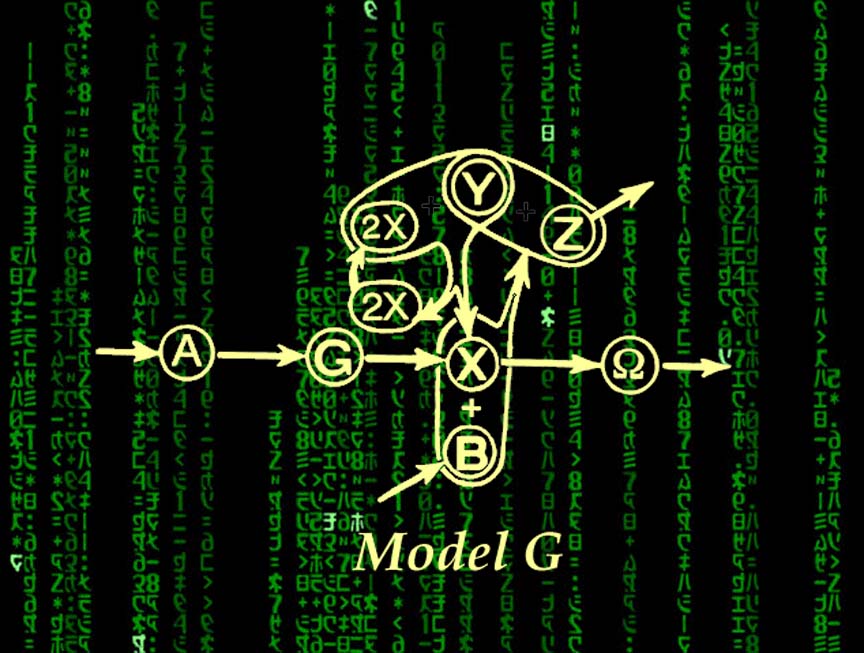 A collective mapping of the five ether reactions that form Model G
A collective mapping of the five ether reactions that form Model G
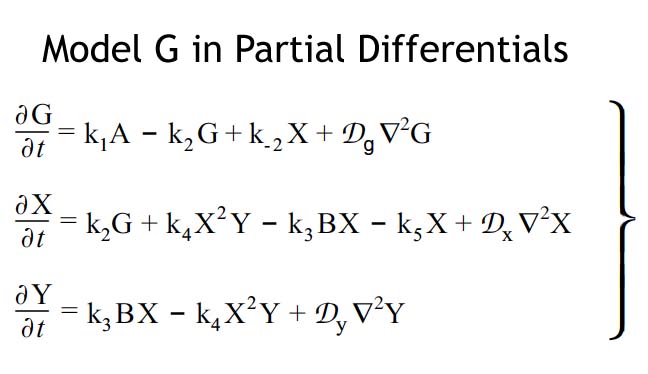 Quantities A, B, G, X, and Y represent ether reaction concentrations. The k parameters represent the kinetic constants of the ether reactions. Finally, the Dx and Dy parameters denote the diffusion coefficients for the X and Y ethers.
Quantities A, B, G, X, and Y represent ether reaction concentrations. The k parameters represent the kinetic constants of the ether reactions. Finally, the Dx and Dy parameters denote the diffusion coefficients for the X and Y ethers.
Posted by: Paul LaViolette
March 1, 2014
First a Brief Summary About Model G
Model G is a nonlinear ether reaction-diffusion system which subquantum kinetics postulates to be the generator of our physical universe. It is simple and elegant. It is the philosopher's stone that physicists have been seeking in their search for an effective unified field theory. While very simple, this reaction-diffusion system exhibits highly complex behavior that so far has correctly predicted in advance a number of structural features of subatomic particles discovered in the last 15 years through particle scattering experiments.
Subquantum kinetics hypothesizes that spatial and temporal variations in the concentrations of the G, X, and Y ether variables displayed above constitute the matter and energy quanta that form the basis of our physical world. These three ether variables and their source and sink ethers (A, B, D, and Ω) denote concentrations of discrete etheric components called etherons that are hypothesized to fill all of space. These entities are too small to ever be individually observed by physicists measuring instruments, but they are hypothesized to diffuse freely through space and to spontaneously react with one another. Empty space and solid matter are both theorized to be filled with these ether on components. The total medium composed of these intermixing and reacting components we call the transmuting ether. Under the proper conditions (proper values for ether on concentration, kinetic constants, and diffusion coefficients), these collective reaction-diffusion processes are able to produce extended spatial structures called dissipative solitons which are accurate representations of subatomic particles.
The field potentials forming a material particle are in essence ether concentration patterns sustained by such reactions transpiring in and propagating through the ether. The smallest observable objects, subatomic particles, then are actually not solid objects, but steady-state concentration patterns composed of far smaller underlying components. Reacting and diffusing etherons form subatomic particles in much the same way that reacting and diffusing paraffin and oxygen molecules form the ordered plasma of a candle flame. Both are examples of open systems whose structural form is continuously generated and renewed by processes occurring at the subsystem level in the system hierarchy.
.
The G ether concentration variations in Model G correspond to physically observable variations in gravity potential and the X and Y ether concentration variations correspond to physically observable variations in electric potential. The reciprocal, complementary action of X and Y is what creates bipolarity, subatomic particles that exhibit the two electric polarities: positive vs. negative charge, or matter vs. antimatter configurations. As a result of Model G's electrogravitic coupling, this same bipolarity characterizes the subatomic particle's gravity potential field yielding bipolar positive and negative mass states. Magnetic effects are generated by moving electric fields; i.e., X-Y ether fluxes.
For more about subquantum kinetics, see the Starburst Foundation ether physics pages.
.
The Model G Simulator
Below is a simulator of this Model G ether reaction-diffusion system that simulates the three partial differential equations displayed above to show a particle structure spontaneously emerging from "empty" (matter-free) space. Note that it runs best on newer computers; e.g. vintage 2010 and later with the most up to date web browser. The simulator is currently set up to generate a one-dimensional representation of a dissipative soliton; i.e., representing the emergence of a primordial neutron from a spontaneously emerging zero-point energy fluctuation. Just press the "run" button at the bottom. The reaction-diffusion system parameters must be chosen to be close to the values given in the left column, otherwise the system will not generate a soliton structure. You can experiment by altering the provided values and pressing "run" to see the outcome. When finished you may reset the simulator by pressing the webpage reload button on your browser. A similar simulator has been posted by Matt Pulver on the Blue Science website at: https://blue-science.org/sims/reaction_diffusion/.
The 10 parameters on the left are defined in Eqn. (8) in the paper by Pulver and LaViolette (2013). They represent the following: Parameters dx and dy set the values for the X and Y ether diffusion coefficients relative to the G diffusion coefficient; i.e. dx = Dx/DG and dy = Dy/Dg. Parameters a and b set the concentration values for the initial reactants A and B, and u and w set the concentration values for the final products Z and Ω. Parameters g, p, q, and s set the ratios for various kinetic constants. The homogeneous steady state concentrations for the reaction variables, G0, X0, and Y0, are specified as follows: G0 = (a + gw)/(q - gp), X0 = (pa + qw)/(q - gp), Y0 = [(sX02 + b)/X02 + u]X0 . For ease of display, the simulator's graph plots the X reactant at one tenth of its actual concentration in order that its plotted wave amplitude be comparable to the wave amplitudes of the G and Y reactants.
The Starburst Foundation wishes to thank Matt Pulver for creating this Model G simulator. Also thanks to David Jonsson for his contribution to the simulation effort and his suggestion that we develop a Model G simulator that could be run on a web browser.
.
Experiment No. 1: Showing the particle formation results of a fluctuation emerging in an ether environment that is either a) modestly supercritical, b) subcritical or c) excessively supercritical.
In playing with these values, you will find that a stable particle is formed when parameter g is within the range 0.092 to 0.1025. Above the upper limit of this range, when g > 0.1025, the reaction system enters its subcritical mode and any ordered structures will progressively dissipate. For example, choose g = 0.1026 to see what happens. A subatomic particle will initially form due to the temporary core supercritical region created by the initial seed fluctuation. But when the seed fluctuation recedes and the particle is left on its own, its amplitude will gradually diminish and it will ultimately vanish. The simulation should be allowed to run several minutes to see this. As one chooses progressively higher values of g, the reaction system will become increasingly subcritical and the nucleated particle will vanish in an increasingly shorter time.
So when g = 0.1025, the system is at its critical stability threshold. At this value, Model G would be marginally stable, or could be said to be in a condition of having Lyapunov stability. This would correspond in physics to the condition of perfect energy conservation, where a photon would neither blueshift nor redshift over time. Based on the equation given above, for the chosen parameter values, this threshold would correspond to a steady state G ether concentration of G0 = 15.59889. We may identify this concentration with the zero gravitational potential; i.e., φG = 0.
When G drops below this threshold, i.e., for G < 15.599 or negative gravity potential values (φG <0), Model G will be supercritical. But there is a range of G values in this negative G potential supercritical domain where Model G is able to adequately form a particle-like dissipative soliton. This spans the g parameter range 0.092 < g < 0.1025. In terms of G concentration, this range would span 15.419 < G < 15.599, or in terms of gravity potential (φG = 15.599 - G), it would span the range from -0.18 up to zero.
But when the g parameter drops below 0.092, the particle field pattern develops an oscillation in its inner shell that eventually causes progressive shell growth and the relentless nucleation of adjacent particles nested core-to-core. This instability threshold corresponds to a G concentration value of G < 15.419, or gravity potential value of φG < -0.18. You can observe this by choosing a g value of 0.091 or less. As can be seen, the outer Y max shells of the soliton grow into particle cores. At progressively lower values of g, or more negative values of φG, this periodic structure will extend and become more pervasive, eventually producing an extended space structure pattern resembling that generated by the supercritical Brusselator. In a 3D simulation, this mode would produce a nested array of particle cores (e.g., closely packed neutron particle cores) and would actually be a realistic depiction of the inside of a neutron star. In other words, this extended periodic structure would represent neutronium (neutron degenerate matter). The prevailing supercritical conditions would make the neutrons more stable and unlikely to decay into protons.
Note that a g parameter value of 0.091, would correspond to a φG potential of -0.197, so that the zero potential value in the simulation would itself be below the threshold of marginal stability by a 0.197. Thus even the φG hills in the particle's soliton "Turing wave pattern" would be submerged into the supercritical regime.
.
Experiment No. 2: Showing how varying the diffusion coefficients of the X and Y reactants can alter the level of ether criticality and change the outcome of matter formation.
By either increasing the value of the Y diffusion coefficient (i.e., increasing parameter dy) or by decreasing the value of the X diffusion coefficient (i.e., decreasing parameter dx) the system becomes supercritical with wall to wall structure. Try this. Doing the opposite, causes the system to become subcritical and the soliton to dissolve. For example, try decreasing dy or increasing dx. This accords with the behavior of the Brusselator. For example, eqn. 3-5 and 3-6 in Subquantum Kinetics, taken from Nicolis and Prigogine, 1977, refers to the Brusselator. It shows that the ratio Dy/Dx in relation to the value of the concentration of initial reactant B is significant in determining the reaction system criticality; e.g., (Dy/Dx)½ > [(B - 1)½]/(B½ - 1) to allow the formation of ordered patterns. A similar equation able to apply to Model G would need to take into account the reverse reaction kinetic constants (which in the Brusselator are assumed to be zero).
.
Experiment 3: Showing how varying the concentration of the B ether reactant can change the criticality of space and thereby produce large scale structure in the universe through its effect on matter creation.
Also note that by increasing parameter b (increasing the concentration of ether reactant B), the reaction system becomes more supercritical and by decreasing parameter b (decreasing the B ether concentration) it becomes more subcritical. Try this. In previous publications, have suggested that a periodic spatial variation in B ether concentration spanning hundreds of megaparsecs can create supercritical regions spaced apart by subcritical regions which may explain the development of galaxy cluster walls, strings, and voids that together form the cosmic web; see below. That is, B would directly influence the rate of particle materialization in space.
.
Those interested in obtaining a version of this simulator that can be run on your computer, contact Matt Pulver. His email address is given in the above mentioned IJGS paper.
Hawking finally sees the light: Says black holes do not exist
.
Paul LaViolette
January 27, 2014
Physicist Stephen Hawking has now reversed his stand on black holes. He gives his reasons in a paper that he posted five days ago on the physics preprint internet archive at (https://arxiv.org/abs/1401.5761). He says that according to his new analysis "There would be no event horizons and no firewalls. The absence of event horizons mean that there are no black holes - in the sense of regimes from which light can't escape to infinity." He says that the concept of a black hole should be "redefined as a metastable bound state of the gravitational field" which has a chaotic interior. In other words, he now envisions that a supermassive Galactic core should be a collapsed region from which energy can escape through an "apparent horizon". An apparent horizon is described as a surface that traps light but which also varies its shape due to quantum fluctuations allowing the possibility for light to escape.
His new stand on black holes has caused quite a media frenzy since Hawking had been an early developer and long-time supporter of black hole theory dating back as far as 40 years. Here are a few links to media stories:
Nature.com
Foxnews.com
news.com.au
For many years I have argued against the black hole idea, which has been a very unpopular stance to take among physicists. For example, as early as 1985 when I first published subquantum kinetics in the International Journal of General Systems (Special Issue on Systems Thinking in Physics), I wrote "Black holes would not exist in a subquantum kinetics cosmology" (LaViolette, 1985, p. 342). I explain that this is because a black hole gravitational singularity is unable to form in subquantum kinetics. Furthermore even a quasi singularity that Hawking calls a "bound state of the gravitational field" would be unable to form. One reason is that the gravitational field of a subatomic particle does not rise to infinity at its center, but rounds off to a plateau at the particle center, thus preventing unrestrained gravitational collapse. This predicted particle profile is apparent in simulations performed of subquantum kinetics' Model G and this contour for the particle's nuclear electric field has been confirmed through particle scattering experiments. Thus as particles approach increasingly close to one another, their mutual gravitational attraction approaches zero instead of infinity.
Another reason singularities are unable to form is because a star continuously produces enormous amounts of genic energy (spontaneously generated nascent energy) which effectively opposes any gravitational collapse even when fusion reactions have died out. Red dwarf stars (M < 0.45 Msolar) are 100% powered by genic energy; about 12% of the Sun's radiation is of genic origin; and only a few tenths of a percent of the energy radiated by a 20 solar mass blue giant star is of genic origin. But when fusion burning subsides and a blue giant begins to gravitationally collapse, the genic energy production equations predict that genic energy sky rockets and becomes the dominant stellar energy source. The result is a very dense stellar core that I have termed a Mother star, which continually creates, radiates, and ejects both energy and matter. Smaller Mother stars are objects astronomers call neutron stars, X-ray stars, and magnetars. Mother stars that have grown far more massive over their billions of years of existence are what astronomers observe as supermassive Galactic cores. Those interested to learn more about genic energy are referred to various papers (LaViolette, 1992 and LaViolette, 2005), the following webpage on the Pioneer effect, as well as the verification of Prediction No. 3. For further discussion about the problems with the black hole idea view the following webpage: Five Reasons Why the Milky Way's Core is Not a Black Hole. For the most thorough treatment of the nonexistence of black holes and the reality of genic energy and matter creating Mother stars, read the book Subquantum Kinetics (4th edition).
Over the years I have continued to maintain my stand against black holes throughout the years and have bolstered this with observational evidence that counters the black hole idea. So to hear that Hawking now admits, after many decades, that black holes should not exist is music to my ears. But Hawking still has a long way to go to make the journey from the classical black hole concept to the Mother star concept of subquantum kinetics. Hawking still believes that any energy radiated from a Galactic core, which he views as a metastable bound state of the gravitational field, would come entirely from the accretion of surrounding matter. For one thing, he would have to relinquish this idea and embrace the subquantum kinetics idea of genic energy. It is this energy that supermassive Galactic cores radiate and which keeps in check their further collapse. Genic energy unabashedly violates the First Law of Thermodynamics (the law of energy conservation) as conventionally construed. Physicists who adopt the closed system positivist view that the only real existents are physically observable phenomena would find this idea intolerable. However those adopting the wider perspective that the physical universe operates as an open system and is part of a much more expansive higher dimensional environment that remains inherently unobservable to us, then the genic energy concept becomes quite acceptable. Ultimately, if physics (and society) is to progress, physics will need to move towards this latter view which not only comes closer to age old spiritual teachings but also opens up a golden age for humanity based on the commercialization of over-unity energy generation technologies and gravity defying propulsion devices; see the December 2013 news posting.
The subquantum kinetics Mother star idea does not deny the possibility that there is a radius within which light rays approaching tangent to the surface of the Mother star would become trapped in a closed orbit. If we identify this radius with the classical concept of the Schwarzschild radius, such a light trapping horizon would likely lie in the Mother star's interior in the case of the Milky Way's galactic core. For example, to my best estimation, the surface of the Sgr A* Mother star would lie a radius of about 22 solar radii from its center, whereas the ungravitationally lensed Schwarzschild radius for this supermassive body would be 19 solar radii, just below the surface of the Mother star. But light rays traveling radially outward from the surface of Sgr A* or at an angle to the surface would radiate outward without a problem; although they would be gravitationally redshifted by about 45%.
How does Hawking's revised view relate to the upcoming G2 cloud encounter with the Galactic core that astronomers are so closely following? Well, current papers describing this encounter are based on the standard black hole theory and the assumption that the Galactic core has an event horizon through which no matter or radiation can escape. This model must be dispensed with on the basis of Hawking's new view. According to this new view if a massive body such as a one solar mass star were to fall into the Galactic core (and there is a relatively small probability that this might happen during the G2 cloud/star encounter), all the energy released from its infall could be explosively discharged back out as a cosmic ray volley accompanied by X-ray and gamma ray radiation. If we go beyond Hawking to the subquantum kinetics view, not only would such an infall allow the release of the energy of mass infall, but it could ignite an exponential rise in the genic energy being produced by our Galactic core Mother star and this as well could be radiated outward to the rest of the Galaxy resulting in an energy output many of orders of magnitude higher than the total energy released from the infall of the star alone. In short, it could possibly ignite a Galactic core explosion of the kind seen in Seyfert galaxy nuclei. The magnitude of this energy release and the finding that cosmic rays from such an event would begin impacting Earth about the same time would come as a total surprise to current astronomers who operate on the classical black hole idea. If this scenario happens, they had best stay indoors and keep out of harms way.
The Reality of Overunity Generators: Evidence for an Open-System Universe
The Reality of Overunity Generators:
Evidence for an Open-System Universe
Essay by Paul A. LaViolette
December 2013
© Paul LaViolette, 2013
There are two energy generation processes that operate in the universe: conservative energy generation and nonconservative energy generation. Standard physics recognizes only one of these sources, conservative energy generation. But in doing so it leaves a large number of observed energy generation phenomena unexplained, as for example overunity generators that produce energy without consuming fuel. Let us review these two classes of technologies and start first with the conventional technologies that are currently sanctioned by society.
.
Conservative Energy Generation Processes
Conservative energy generation processes are processes that are fuel burning, where a material in a low entropy state (high potential energy) is converted into a high entropy state (low potential energy) with the release of energy or production of work. There are a large number of examples that one can point to that fit in this category:
• Fossil fuel combustion
• Rocket propulsion
• Nuclear fission
• Nuclear fusion
• Low energy nuclear transmutation
• Solar energy
• Geothermal energy
• Energy from subground state electron orbit transitions
____________________________________________
The paragraphs below summarize some examples of the energy conserving transformation processes that power such modes of energy generation. Since these are familiar to many, some may want to skip this section and go on to the next page which presents a novel explanation of the origin of energy powering overunity (nonconservative) energy generators.
____________________________________________
In the case of fossil fuel combustion, fuels such as wood, coal, oil, natural gas, or gasoline, (having high chemical potential energy) is converted through oxidation into water, carbon dioxide, carbon monoxide and a host of atmospheric pollutants, all of which are reaction by-products having low chemical potential energy, and to release low entropy heat dissipated to the environment. In the case of rocket propulsion, a fuel such as liquid hydrogen and oxidizer such as liquid oxygen, having a high chemical potential energy, is ignited to produce water vapor, which has a low chemical potential energy, and to as a consequence release a copious amount of low entropy heat and mechanical energy. In the case of nuclear energy, a nuclear fuel such as uranium-235 which has a high nuclear potential energy, is triggered by neutron bombardment to convert into barium-144 and krypton-89, which have low nuclear potential energies, and to release high energy neutrons and gamma rays which collide and degrade into low entropy heat. Both thermonuclear fusion and low energy nuclear transmutation would also be energy conserving. In the case of the Rossi/Defkalion cold fusion device, higher potential energy nickel isotopes become converted into isotopes of copper along with the release of some gamma ray radiation. In the case of solar energy, photovoltaic conversion for example, sunlight radiation which comes from a low entropy, high temperature source, the Sun, is converted into low entropy heat and electric voltage potential. In the case of geothermal energy, geothermal heat at a high temperature, low entropy state is radiated to the environment as low entropy heat.
Another conservative energy generation process involves energy derived from electron orbit transitions in the hydrogen atom where orbital electrons are induced to drop to subground energy states. Examples of this are the water heaters produced by Randall Mills and his BlackLight Corporation and by C. Eccles and the EcoWatts Corp. This is a phenomenon whose explanation lies outside of standard physics since standard theory maintains that there are no orbital states in hydrogen below the Bohr orbit ground state. However, various theories do predict the existence of these subground energy states, the subquantum kinetics physics methodology being one such theory. So the energy released in such devices may be attributed to energy conserving transitions where electrons jump to such lower orbital levels the energy difference being release from the hydrogen atom through collisional excitation of catalytic molecules dissolved in the water solution.
All of these processes are energy conserving in that energy in equals energy out. That is, the change in energy potential when the fuel is converted into lower potential reaction by-products is equal to the resulting mechanical energy and dispersed heat energy. If this entropy increasing process is harnessed to produce useful work, then the energy of the work produced must also be included in the energy-out side of the equation. In the case of solar and geothermal, the energy embodied in the high temperature source, either the Sun or geothermal water, is equal to the energy content of the low temperature dispersed heat energy, along with any mechanical or electric power output that is produced. All of these processes obey the first and second laws of thermodynamics and Newton's third law. They all tap into a pre-existing fuel source such as wood, oil, nuclear fuel, the Sun, the Earth's radiating energy, etc. In these cases, if the fuel is naturally existing, it must be mined, and often it must be refined. Solar energy mining involves simply exposure to the Sun. Geothermal mining involves drilling for geothermally heated water. In the case of rocket propulsion, the fuel must be fabricated using the energy of one of these other sources for its preparation.
All of these conservative energy generation processes have explanations that lie within the theoretical framework of standard physics and chemistry and hence they are understood and supported by standard physicists and chemists and sanctioned by governments. They, however, are expensive to harness and many of them pollute the environment. Even solar power production, if not done appropriately, can be said to aesthetically pollute the environment through the construction of fields of solar arrays that disrupt the beauty of nature.
.
Next Page: Nonconservative Energy Generation Processes
Independent Confirmation of the Arrival of 8 Minor Superwave Events in the past 1300 years

In June 2012, a group of Japanese researchers Miyake, et al. announced in Nature magazine that they had found evidence of a sharp increase in radiocarbon (1.5 percent in one year) in tree rings dating from 774 to 775 AD. This indicated that on that date the Earth had been exposed to an intense pulse of gamma rays or cosmic rays. As a cause, they ruled out that it had been caused by a solar proton event or a nearby supernova. Hambaryan and Neuhaeuser (2012) concluded instead that the C-14 spike must have been caused by an energetic astronomical event of unknown origin and tentatively proposed that it may have been due to a short gamma ray burst produced either by the merger of two white dwarfs or by the accretion induced collapse of a white dwarf.
At the time of their publication, the discoverers were apparently unaware that in my 1983 Ph.D. dissertation and subsequent publications (e.g., Earth Under Fire, chap. 12), I had predicted a date very close to this for the arrival of a small superwave cosmic ray volley from an outburst of the Galactic core which was one of 13 such dates predicted for the period from 5300 BP to the present; see date prediction table below. I based these on dates for the expulsion of ionized neon gas clouds from the Galactic center which came from the observations of Lacy et al. (1980). To get these expulsion dates, Lacy et al. first measured the diameter of each neon cloud. To calculate a cloud's diameter they measured its angular size, and figuring the cloud's distance from us (i.e., the distance between the Galactic center and the Sun since these lay near the galactic core) and using trigonometry, they were able to calculate its physical diameter in light years. Then they measured the cloud's expansion velocity by observing the Doppler shift of its ionized neon emission lines. Knowing each cloud's diameter and expansion velocity, they were able to infer its explosion date, i.e., the date when the cloud would have had a zero diameter.
In their date calculations Lacy et al. had assumed a galactocentric distance of 10 kpc, whereas I had assumed an Earth-to-Galactic-center distance of 7.06 kpc (i.e., 23,000 light years). Astronomers today often quote the distance to the GC to lie in the range of 7.4 to 8.7 kpc, closer to the distance that I had assumed in my calculations 30 years earlier, although several studies have subsequently agree with the smaller value that I had adopted [e.g., 7.1±1.5 kpc (M. Reid, 1986), or 7.1±0.4 kpc (Olling and Merrifield, 1997)].
I had made the assumption that these gas expulsions were each accompanied by a minor energetic outburst and isotropic release of a cosmic ray volley that traveled to Earth at essentially the speed of light, hence far faster than the gas expulsion itself. I theorized that these cosmic rays would have arrived within days or months of the date that the core eruption would have been visible. Such a superwave would have been energetic enough to account for the spike that Miyake, et al. have found.
As we see, the 774 AD C-14 spike discovered by Miyake, et al. falls within 28 years of my 746 AD superwave prediction, hence a confirmation to within the error limits of the prediction. The error bars for the dates are due to uncertainties in knowing the exact diameter of each neon cloud, its precise expansion velocity, and its distance from us. Hopefully more accurate observations of these ionized neon clouds made in the future can reduce the uncertainty of these measurements and allow these dates to be pinpointed more accurately.
More recently, Miyake et al. (2013) announced finding another C-14 spike in the tree ring record that dates from 993 to 994 AD. This date coincides precisely with one of the superwave arrival dates that I had predicted; see above table. This C-14 event was of somewhat lesser magnitude, about 70% of the C-14 rise produced by the 774 AD event. They also report beryllium-10 peaks correlating for both the 774 AD and 993 AD events seen in an Antarctic ice core and suggest that these peaks could be due either to a very large solar proton event (SPE) or to a gamma ray burst. Whereas they had previously ruled out a super SPE due to the lack of any extinction episode in the geologic record, here they have reversed their decision and consider it as an alternative due to the frequency of the events they are finding. Here too, they were apparently unaware of my galactic superwave work and hence made no mention of his apriori superwave prediction. With the posting of this news announcement, I intend to contact this research group to make them aware of these predictions which may offer a more reasonable explanation for these peaks than the solar alternative.
Usoskin et al. (2013) interpret the 774 AD C-14 spike as being caused by a hard spectrum solar proton event of fluence 4.5 X 1010 cm-2, hence about one third of the fluence that LaViolette (2011) had proposed for the event that contributed to the megafaunal extinction at the beginning of the Younger Dryas. However, there is no evidence of a serious threat occurring to human or animal life at that time and no record of a correlating nitrate ion peak in the ice record. So it is highly unlikely that this event or the 993 AD event was due to the Sun. A galactic superwave cause seems more likely.
Several other of the predicted superwave events also match up with events registered in the ice record. The graph shown below (Figure 1), taken from a paper by Horiuchi et al. (2009), presents beryllium-10 influx as registered in the Dome Fuji core from Antarctica. Peaks seen at 1250 to 1350 AD, 1017 AD, 1000 AD, 900 AD, and 780 AD match approximately with the predicted superwave dates 1289 AD, 1020 AD, 993 AD, 943 AD, and 828 AD; see table. The earliest of these events is recorded in the Greenland GISP2 ice core by a 2-1/2 year long acidity spike that dates from 1265 AD to 1267.5 AD; see Figure 2. This cannot be registering a solar proton event since the particle barrage from such events rarely lasts more than two months. Also no volcanic eruptions are known to have occurred during this period. Acidity spikes are also seen in the GISP2 ice core at dates 950 AD, 761 AD, and 754 AD, which may or may not correspond to the 900 AD Dome Fuji date and 774 AD dendrochronology date. The 950 AD and 754 AD acidity spikes have durations of 8 months and 6 months respectively, so they too are unlikely to be due to solar flares. Also an acidity spike of one year duration is seen in the GISP2 ice record dating at 695 AD and which may be registering the 651 AD superwave. Again, due to its long duration, it is highly unlikely that this event is due to the Sun.
Motizuki, et al. (2009) have found a beryllium-10 peak in the Dome Fuji ice core dating about 1010 ± 10 AD that has a duration of about 4 years. They suggest that it may correlate with the 1006 AD supernova explosion which occurred at a distance of 2.2 kpc from our Sun. However, a gamma ray burst from such a type Ia supernova should have had a duration of no more than a few days, and certainly should not have produced a four year peak in beryllium-10. So a galactic superwave appears to be a better interpretation. Motizuki et al. also found brief peaks which they date at ~1060 ± 10 AD and 1070 ± 10 AD. They associate the earlier with the 1054 AD Crab nebula supernova and the later as being produced by unidentified source. Whether these two peaks were produced by superwaves associated with the 1020 AD superwave is left to future determination.
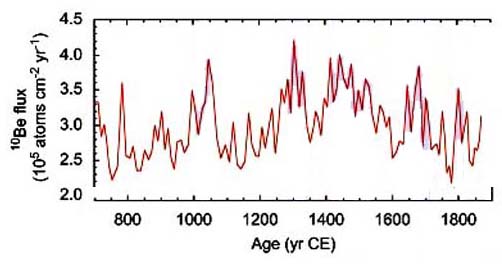
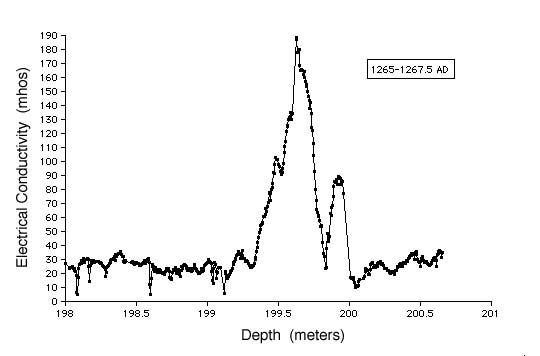
In addition to the above there is a beryllium 10 spike seen both in the Vostok, Antarctica and GISP2 ice records as well as in the tree ring records which lasts about one century and is centered at a dendrochronology date of 3280 BC. This 3300 BC superwave date confirmation is one that I had called attention to some years back. This same event is also registered in the GRIP Greenland ice record by a fairly sizable nitrate ion peak centered at 3266 BC. The whole period from 3390 BC to 3250 BC exhibits elevated acidity in the GISP2 record indicative of a period of high cosmic ray activity. Presumably it had a very large effect on the GISP2 ice record at this time because ice core researchers have omitted data between depths 1030.1 meters and 1032.4 meters corresponding to the dates 3320 to 3335 BC, either because they felt the values were so extreme as to be untrustworthy or because of fracturing of the ice record in this depth range. Also glaciologist Lonnie Thompson had found evidence of abrupt climatic change occurring around 3250 BC (accelerated ice formation in Peru and a dry spell in Africa).
In all, we have noted here that 8 of the 13 predicted superwave events have corresponding anomalies in the terrestrial record indicative of periods of high cosmic ray exposure. The five events predicted to have occurred between 1042 BC and 253 AD have yet to be verified. A search for them in the dendrochronology record or ice core profiles is highly advisable.
Paul LaViolette, Ph.D.
August 25, 2013
G2 Cloud Predicted to Approach Twice as Close to GC
New Developments on the G2 Cloud Journey
Paul LaViolette
There have been new developments in the story on the G2 Cloud. Recent observations of the G2 cloud made in the near infrared at the Keck Observatory indicate that the cloud will reach its closest approach to the Galactic center around mid March of 2014 instead of June of this year. Also the new findings indicate that G2′s orbit will take the cloud twice as close to the GC than previously thought. The distance of closest approach is now predicted to be 130 AU rather than the previous estimate of 266 AU.
If the star embedded in the G2 cloud is a binary system or contains a single star with orbiting planets, there is the danger that the Galactic core may tidally strip away the lower mass companion star or one or more companion planets at the time the stellar system is at orbital pericenter closest to the core. In that case the consequences could be catastrophic. For example, if an entire 100 jupiter mass brown dwarf were to plunge into the Galactic core in one sudden event, it is almost certain that it could jump-start the core into an active Seyfert state and generate a potentially lethal superwave.
For a detailed report on this story, see the May 11th news posting on the Sphinx Stargate website.


